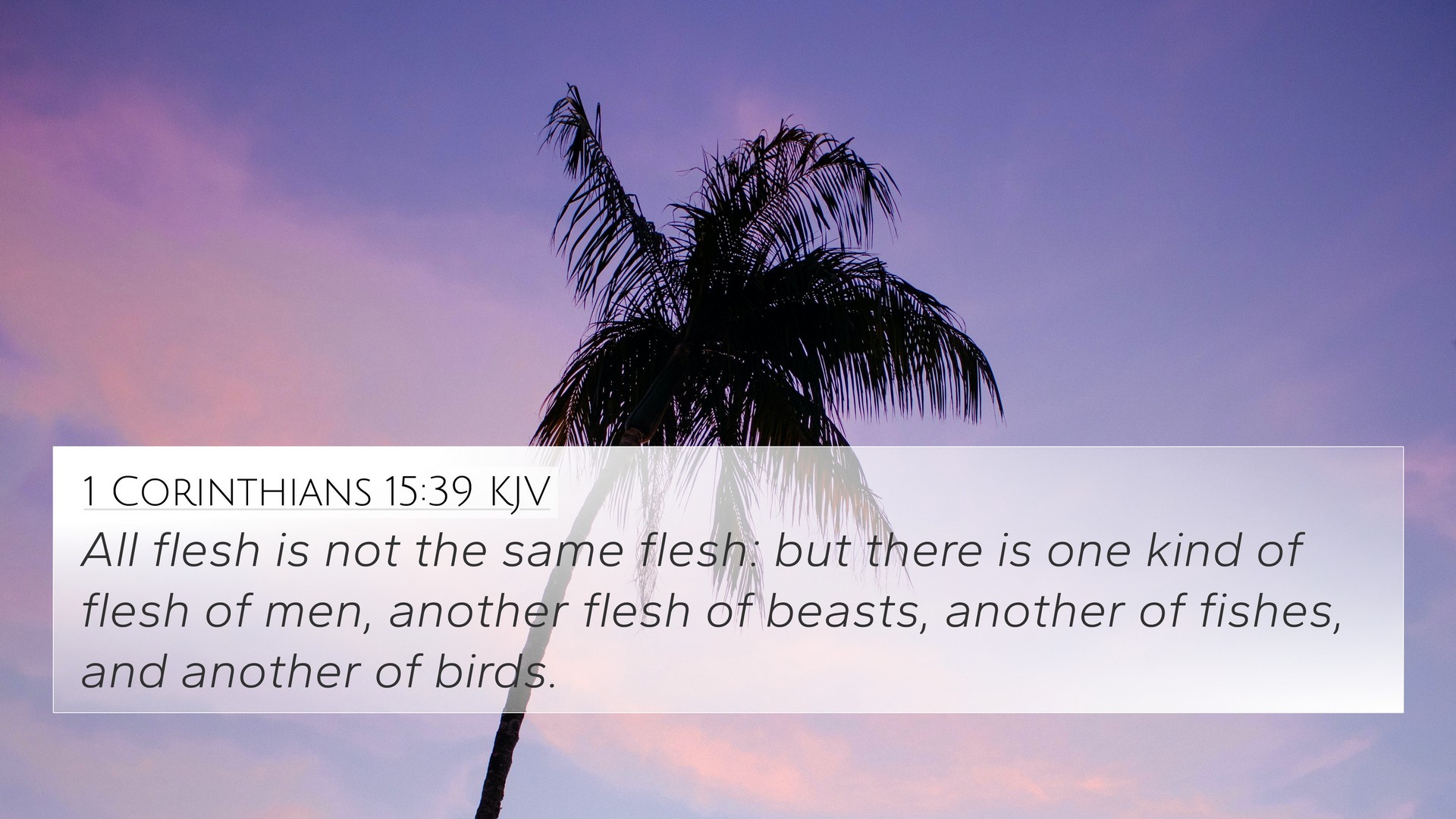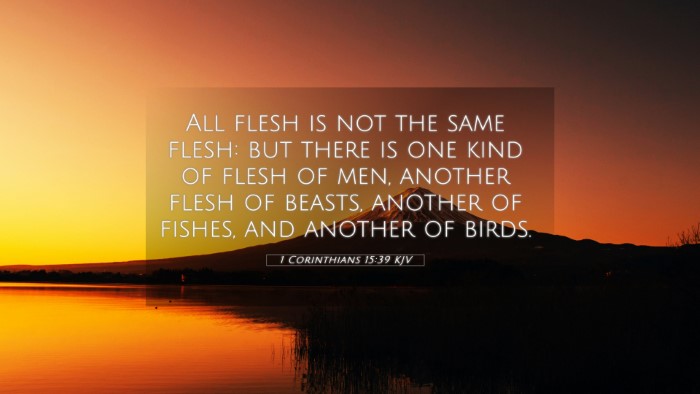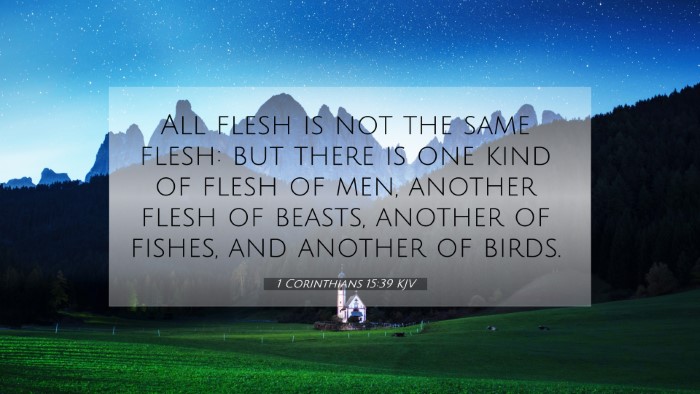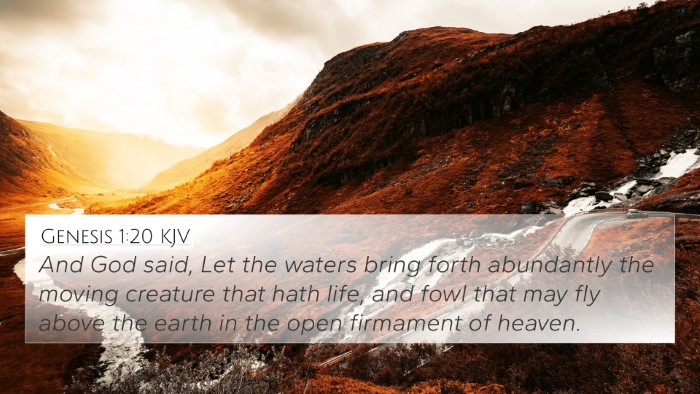Understanding 1 Corinthians 15:39
Bible Verse: 1 Corinthians 15:39 - "All flesh is not the same flesh: but there is one kind of flesh of men, another flesh of beasts, another of fishes, and another of birds."
Overview of the Verse
This verse from 1 Corinthians 15:39 emphasizes the distinction in the types of flesh among different creatures. Paul, in this chapter, is addressing the resurrection of the dead and using various forms of life as illustrations to discuss the nature of resurrected bodies.
Insights from Commentaries
Matthew Henry's Commentary: Matthew Henry explains that Paul delineates the differences in flesh to highlight the unique qualities and distinctions in God's creations. There is a divine purpose and order inherent in the physical makeup of each species, which reflects the Creator’s wisdom.
Albert Barnes' Notes: Barnes elaborates on how this verse serves as a comparison not only of physical forms but also of the spiritual bodies that believers will receive after resurrection. He indicates that just as various types of flesh serve different purposes in life, so too will resurrected bodies reflect our unique relationships with God.
Adam Clarke's Commentary: Clarke notes that Paul's argument serves to remind believers that the resurrected body will not be a carbon copy of our earthly form. Instead, it will be transformed, much like how different creatures have different attributes that are suited to their environments and functions.
Thematic Analysis
This verse is pivotal in understanding the themes of resurrection, diversity in creation, and the transformation of bodies. It speaks to the broader doctrinal truths found in the Scriptures regarding life, death, and the future hope for believers.
Connections Between Bible Verses
1 Corinthians 15:39 connects thematically and doctrinally with many other verses in both the Old and New Testaments. Here are some relatable cross-references:
- Genesis 1:21-25: Discusses the creation of various forms of life, similar to Paul’s assertion of different types of flesh.
- Philippians 3:21: References the transformation of believers' bodies into a glorious form like that of Christ’s resurrection body.
- 2 Corinthians 5:1: Talks about the hope of a heavenly body, contrasting our earthly tent with a building from God.
- Romans 8:22-23: Expresses the groaning of creation and the anticipation of resurrection, which echoes the promises alluded to by Paul.
- 1 John 3:2: Declares that we shall be like Him, indicating a transformation akin to the differences in flesh presented by Paul.
- Job 14:14: Wonders about the hope of a resurrection, affirming the theme present in 1 Corinthians 15.
- Romans 6:5: Affirms that if we have been united with Him in a death like His, we shall certainly be united with Him in a resurrection like His.
- Luke 20:36: Jesus mentions that the resurrected are equal to angels and cannot die anymore, establishing a further distinction in the nature of our resurrected existence.
- Matthew 22:30: Highlights the state of the resurrected in heaven, linking back to the idea of different flesh.
- 1 Corinthians 15:50: Immediately following this verse, Paul explains that flesh and blood cannot inherit the kingdom of God, further illustrating the point he makes in 15:39.
Application and Understanding
The significance of 1 Corinthians 15:39 extends beyond intellectual understanding into practical applications for believers:
- Celebration of Diversity: Recognizing God’s creative design in the variety of life encourages appreciation for all of creation.
- Hope for Transformation: Understanding the promise of a transformed body gives believers encouragement in the face of mortality.
- Reinforcement of Faith: The theological exploration fuels a richer faith in God’s plan for resurrection and eternal life.
- Encouragement for Living Righteously: Knowledge of an eventual transformation should motivate believers to live lives that reflect their identity in Christ.
Tools for Bible Cross-Referencing
To delve deeper into the connections between Bible verses, consider utilizing the following resources:
- Bible concordances for finding related verses quickly.
- Cross-reference Bible study guides available in various formats.
- Software tools that allow for in-depth studies of scriptural connections.
- Study Bibles that include cross-references and notes on related scriptures.
Conclusion
1 Corinthians 15:39 serves as a fundamental text concerning the nature of flesh, life, and resurrection, inviting believers to explore the depths of God's creation and the future hope that awaits. By connecting this verse with various other scriptures, one can gain a comprehensive understanding of the broader biblical narrative concerning life everlasting, the distinctions of God’s creatures, and how these themes converge within the tapestry of scripture.



